Understanding Culture and Race Through The Arts
2023 Vision & Sound Symposium
2023 Vision & Sound Symposium
Sedona Arts Center
15 Art Barn Road
Sedona, AZ 86336
The Symposium will feature a dynamic keynote lecture and interactive workshops, all of which will feature opportunities for professional development certification. This year's Symposium keynote speaker is L’Merchie Frazier, Executive Director of Creative Strategic Partnerships for SPOKEArts in Boston.
Conversations with the artists, facilitated by Sedona Arts Center CEO Julie Richard and CSRD Director Lois Brown, PhD will complement the Symposium workshops and keynote address.
Monday, February 27 9:00 a.m. - 5:30 p.m.
Hotel Accommodations:
A block of rooms has been secured at the Best Western Plus Arroyo Roble Hotel that is close to the Sedona Arts Center. These discounted room rates are based on their availability, so please be sure to book in advance.
| Monday, February 27 Vision and Sound 2023 at Sedona Arts Center |
|
| 9:00 am | Registration & Certification Check-In |
| 10:00 am -10:30 am | Welcome |
| 10:30 am - 11:45 am | Keynote Address Talking Back: Visual Sounds of Resistance Presenter: L’Merchie Frazier Executive Director of Creative Strategic Partnerships SPOKEArts, Boston, Massachusetts |
| 11:45 am - 1:00 pm | Lunch - Provided |
| 1:00 pm - 2:30 pm | Workshop Race, Culture, History and the Work of Art Presenter: Lois Brown, PhD |
| 2:30 pm - 2:45 pm | Break |
| 2:45 pm - 3:45 pm | Roundtable Conversation with Vision & Sound 2023 Artists Moderated by Julie Richard and Lois Brown, PhD |
| 3:45 pm - 4:15 pm | Reflection & Calls To Action |
| 4:15 pm - 5:30 pm | Reception |
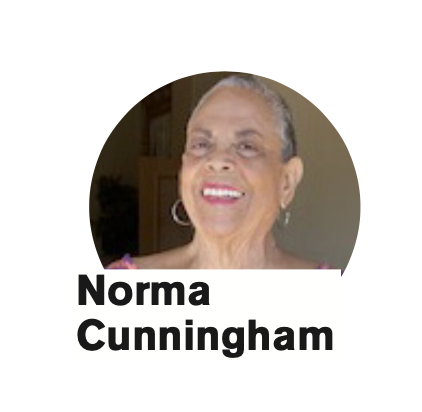

The Cunninghams – Norma as curator and noted chef Michael as artist – are the co-founders of Vision and Sound. Now in it’s eighth year, Vision & Sound features annual February programming that includes symposia, multiple exhibits, artist roundtables, lectures and musical performances. Vision & Sound has provided invaluable opportunities audiences across Arizona, the nation and the world to see, support and learn more about established and emerging African American artists. It is a multi-site event that underscores the powerful connections that the art makes possible between individuals and in communities.
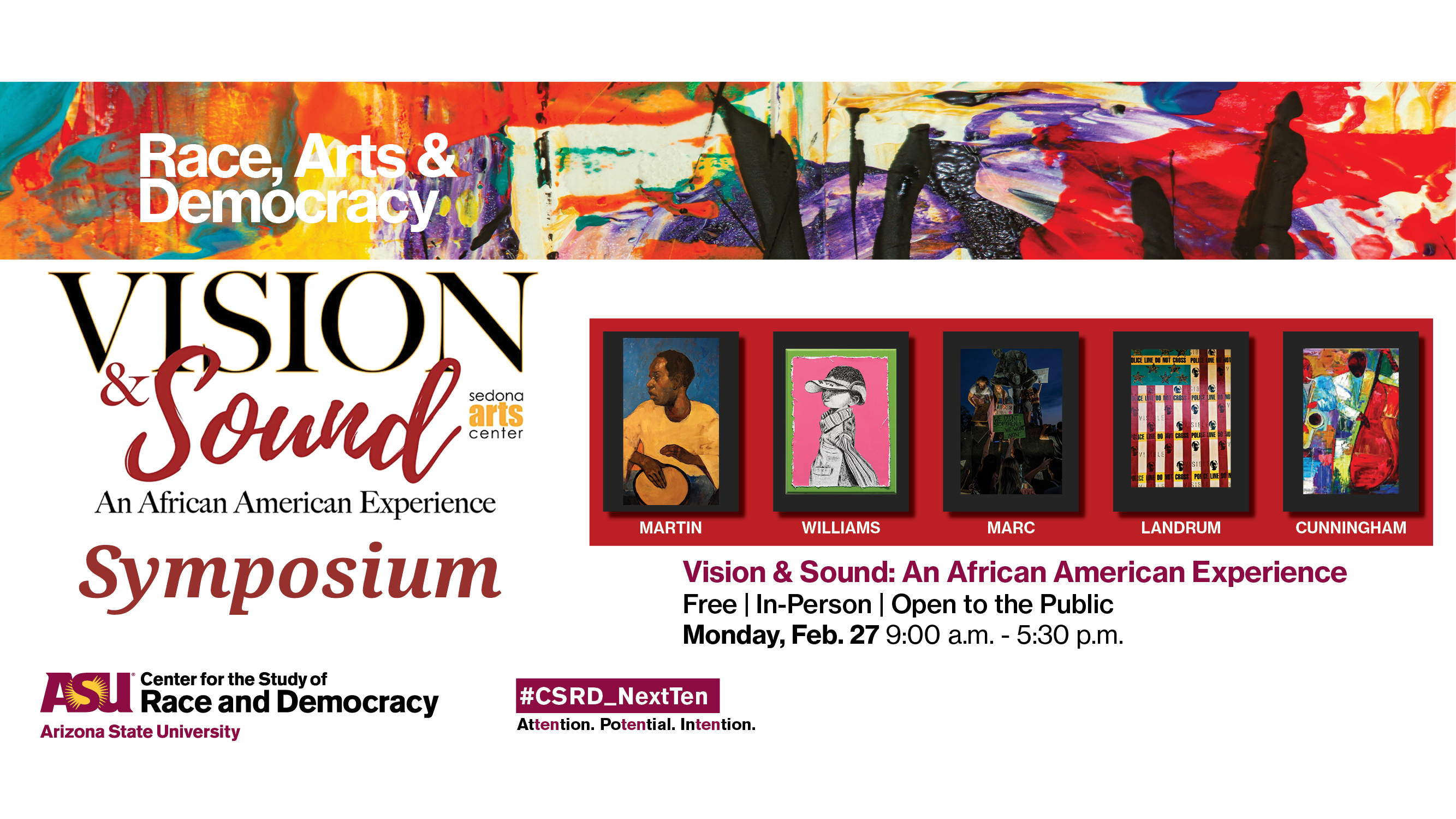
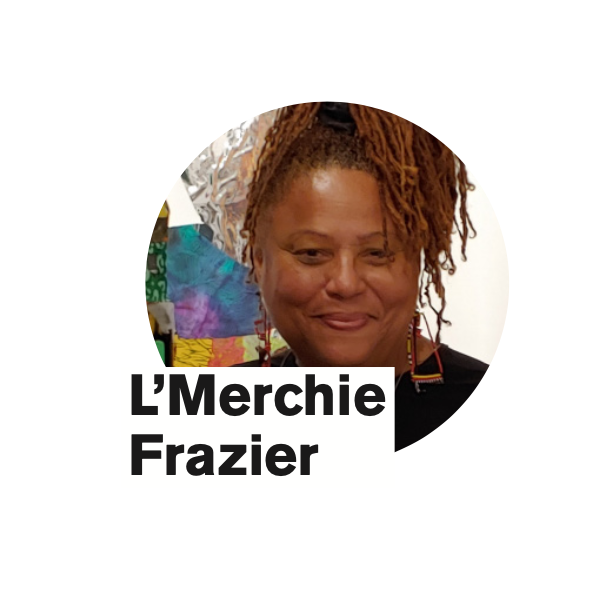
L’Merchie Frazier is a visual activist, public historian and artist, innovator, poet and holographer. She is the newly appointed Executive Director of Creative Strategic Partnerships for SPOKEArts and is Director of Creative Engagement of the Transformative Action Project,/Violence Transformed in the Public Health Advocacy Institute at Northeastern University.
Her work highlights the reparative aesthetic approach to expand the historical narrative, diminishing erasure, responding to trauma, violence and crisis through artistic activities and public art that mirrors community. Her work is based on authentic evidence, providing place-based education and interdisciplinary history pedagogy, programs and workshops, projects and lectures.
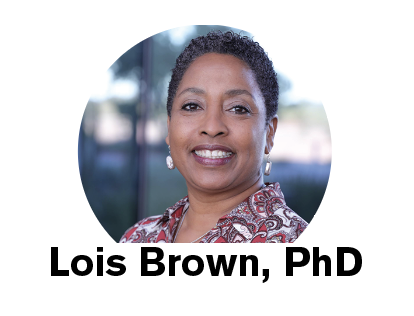
Lois Brown is an ASU Foundation Professor of English and director of the Center for the Study of Race and Democracy at Arizona State University. She is a public historian and a scholar of African American literature and culture whose groundbreaking research reshapes our understanding of race, class, gender, faith, and place in America.
As director of the ASU Center for the Study of Race and Democracy, Brown oversees the only entity at ASU and in the state of Arizona that positions race and democracy in direct relation with each other. Her priorities for the center, which as of January 1, 2021 will be based in the Office of the University Provost, include the creation of initiatives that intensify the intellectual, pedagogical and programmatic efforts of the Center. She is committed to programming, partnerships and outreach that enable the center to focus on race and democracy in the context of education, social justice, public history, poverty and economic opportunity, the arts, law, government, the sciences and the environment. Brown's public speaking and presentations on equity, leadership, justice and inclusion complement the Center's efforts to advance positive systemic change and justice.
Lois Brown earned her A.B. degree in English from Duke and her Ph.D. in English from Boston College. Her first academic love is 17th century British poetry and this continues to inform her work on early American writing, landscape, and narratives about loss, redemption, and triumph. Her books include "Black Daughter of the Revolution: A Literary Biography of Pauline Elizabeth Hopkins," "Memoir of James Jackson, The Attentive and Obedient Scholar" and "Encyclopedia of the Harlem Literary Renaissance." Professor Brown’s current projects include biographies of influential but understudied African American women of the nineteenth century, African Americans in 18th and 19th century Concord, Massachusetts and a collection of essays on race, place and history in nineteenth and early twentieth-century Arizona.
Brown was featured on the acclaimed PBS documentary The Abolitionists and has curated and collaborated on exhibitions for the Museum of African American History in Boston and the Boston Public Library. Brown is an award-winning teacher whose courses include Race, Place and Power in African American Women's Writing, the African American Short Story, Writing on the Land of Freedom: The Pastoral in African American Literature, Slavery and the Literary Imagination and Reel Black: African American Life in Film.

Vision and Sound 2023 is presented by the Sedona Arts Center in partnership with the ASU Center for the Study of Race and Democracy and is supported by generous grants and sponsorships. Chief Executive Office Julie Richard oversees the organization that became the Sedona Arts Center in 1961 after an official renaming. 1994 was the year of expansion with the addition of a new building to house an art gallery, classroom space, and the community theatre, which was founded in 1970. In 2001 the mission was redefined to focus primarily on education through the School of the Arts and gallery exhibitions of the visual arts. The School of the Arts has become a catalyst for creative development for students of all ages, from the very young through the golden years of life.
Today the Sedona Arts Center is a rich legacy of the founders’ vision. As one of Northern Arizona’s oldest 501(c) 3 nonprofit organizations it continues to be a gathering place where artists and those who love art can explore, teach and exhibit. The Arts Center has grown into an educational institution dedicated to nurturing creative discovery, learning and sharing through arts education and artistic development with an international presence.

Aaron Allen Marner is a native Phoenician currently working as a full-time and self-taught artist. He was heavily involved in art as a child. Ten years ago in Los Angeles, his passion and love for art and painting was reignited. Since then, he has been honing his craft and exhibiting work in various spaces. His art career has led to life changing opportunities and notable experiences. These include being spotlighted by the Phoenix Art Museum as an emerging artist, having solo interdisciplinary shows at Arizona State University, gaining gallery representation from Framed Gallery of Cleveland, Ohio, creating public art displays, creating his own pop-up art gallery called Pink Elephant and having his work shown in the Children's Museum of Phoenix.
While mostly working with acrylics, acrylic pen, oil and spray paint, Marner’s approach to portrait and figurative painting includes using collage style and vibrant, colorful hues while often adding geometric shapes and aspects of nature. His work conveys a sense of abstraction and surrealism and is not subjugated by one style. Texture, heavy application of acrylic paint, palette knife strokes while using a more monochromatic style has become a vast part of my creativity.
The purpose in Aaron Allen Marner’s work often is to convey his experiences but also to give viewers a sense of power and emotion. His mission is to inspire youth as well as anyone who dreams of becoming an artist and he believes that representation is essential. “Having the ability to see someone who looks like you and who is from the same community as you,” he says, “ gives individuals the motivation to pursue their passion in art.”

Bob Martin is a native New Yorker who was surrounded by Art, jazz, dance and basketball while he was growing up. He believes that “Creating Art is a real opportunity, to be honest, with no need for an explanation or a defense.’ He believes that “Art is not a prelude to what is to come . . . it has its own life” and, that as the poet-theologian-activist Thomas Merton once said, “Art enables us to find ourselves and lose ourselves at the same time.”
Martin has been creating Art and exhibiting for almost sixty years. He studied Art at the N.Y. School of Visual Arts and The Art Students League of New York with Barry Zaid, Peter Cox, Harvey Dinnerstein, David Lefell, and Ted Seth Jacobs. His most recent one-person shows and group exhibitions have been featured across Arizona in such sites as ASU Gammage, the Goodyear Library, the West Valley Museum of Art, Olney Gallery at Trinity Cathedral, Estrella Mountain Community College and the Sedona Art Center.

Born in Detroit, Michigan, Jacqueline Chanda’s talent for drawing was discovered at an early age. She earned her undergraduate degree in painting and drawing from University of California, Los Angeles. Graduate school led her to Paris, France, where she studied visual arts, art education and plastic arts, theory and aesthetics at the École Nationale Supérieure des Beaux Arts and the Sorbonne University. While there, she participated in Académie de Port-Royal open studio sessions and exhibited works at the Grand Palais and the Galerie Louis Soulanges. After a successful career in teaching and higher education administration in art education, she returned to her initial love--making art—and Jacqueline is now a full-time artist living in Tucson, AZ.
Chanda has been the recipient of a Research and Professional Development Grant from the Arizona Commission on the Arts, an artist residency at Hypatia-in-the-Woods in Shelton, WA and an artist fellowship-in-residency at the International Women’s Center in Santa Fe, NM. She has participated in solo and juried group competitions and exhibitions at local, national and international levels. Publications about her art have appeared in the Cliente Magazine of the Arizona Daily Star, Sonoran Arts Network Art Review, Tubac Gallery Guide, Lovin' Life After 50 and The Desert Leaf Magazine. She is represented by Más y Más Gallery in Tubac, AZ, the Toscana Gallery and Studio in Oro Valley, AZ, Calloway Gallery of Fine Art in Georgetown, DC, and Eisele Fine Art Gallery in Cincinnati, OH.
As a representational oil painter, Chanda combines narration with figuration and tells stories that invite the viewer to reflect. Her intent is to share and present familiar situations, common places and circumstances that ask the observer to relate on a personal level to the work of art, to read the situation and to respond in some way so that they complete the stories for themselves.

Born in Jackson, Michigan, Jenita Landrum earned her BFA degree from Arizona State University and her MFA degree from The Ohio State University. She has studied with and been mentored by artists Sam Gilliam, Rip Woods, Jacob Lawrence and Pheoris West. Her work is part of collections at the Mesa Community College Library in Mesa, Arizona, Jackson Community College in Jackson, Michigan, the King Arts Complex in Columbus, Ohio and the Dial Corporation in Phoenix, Arizona.
Landrum describes her voice in art making as a response to layered societal problems and issues that may affect black lives and gender and that encompasses a range of ethnic groups and class status. The series “Black Male Energy” and “We The People” counteract the views and misconceptions of black identity through abstraction and mixed media. Through abstraction, geometric shape and color, she dispels the perceptions of the black male as a one dimensional being. The paintings explore each man, revealing their personal inner voice on what Black man identity looks and feels like. They reveal layers of emotions, venerability, passion, spirituality, compassion, love, kindness, thoughtfulness, anger and grace.
Landrum’s “We the People” Series examines who and how black people have and are looked upon in the United States. She sees the works as narratives of self-identity that speak through personal voice, abstraction, color, and geometric forms that show how colors, shapes and mixed media can give insight into portraiture and emotions.

A self-described multi-media artist for more than sixty-five years, Joe Willie Smith was born in Elaine, Arkansas. His family moved from Arkansas to Milwaukee, Wisconsin during the Great Migration. He recalls that during his pre-teen years, his mother would collect chipped white plates from the restaurant where she worked and give them to him to paint. He would paint various subjects, make potholders using loops made from recycled rags and he would create flowers made from magazine pages. His mother would sell whatever he created.
Smith scours recycling centers, fields, alleys and thrifts stores for materials. Repurposing materials as media has been a lifelong pursuit. He believes that recycled materials are embedded with a sense of place, natural and cultural history. He also incorporates steel and concrete in his work using these materials as structural elements as well as the mediums. He notes that he will work with whatever medium necessary–sculpture, painting, photography, sound, performance and installation art–in order to realize his ideas.
During the course of his prolific and successful career, Smith has done political graphics for the civil rights movement, owned a graphic design studio, designed information graphics for the media and produced several public art sculptures. His present work focuses on ‘Sonic Sculptures” made from repurposed materials and these works are used in public performances. His current public art reflects community through conversation, observations and stories and he creates work that he hopes will provoke the public to be inquisitive and inspired.

Patricia Bohannon leaves indelible marks on the various art communities of which she has been a part. Born in Chicago, Illinois, she spent two decades in Atlanta, Georgia and now lives in Goodyear, Arizona. She was introduced to the world of art in elementary school and she honed that interest during high school. She graduated with high honors from Chicago State University in 1987. Patricia knew that she would one day be a painter and sculptor and she has been successful creating with paints, glass, fiber clay, ceramic, metal and mixed media over the years.
During her inspiring 60-year career, Bohannon has participated in countless individual and group exhibitions, taught Art in the Chicago Public School system and in the Fulton County Board of Education. The recipient of innumerable honors and awards, she was honored recently as 2022’s Extraordinary Woman of Color during Black History Month and she was featured on ABC15’s well-known program Sonoran Living. A mother of two, she was married for thirty-nine years, has been widowed since 2000 and, at 83 years young, she is not slowing down. Her work currently is on display at Sedona Art Center in Sedona, Arizona..
Patricia Bohannon uses her gift to inspire and lift the social consciousness of her viewers. “What sustains me as I create,” she says, “is my passion and desire to connect with people and share through visual expression, historical information on the unfamiliar.”
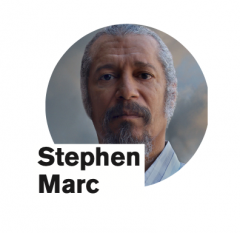
Stephen Marc is Professor of Art in the Herberger Institute’s School of Art at Arizona State University and a 2021 Guggenheim Fellow. In 1998, after twenty years at Columbia College Chicago, Marc joined the faculty at ASU. During Spring 2022, he was honored as the third Stuart B. Cooper Endowed Chair of Photography at Maryland Institute College of Art in Baltimore, MD. Marc received his MFA from Tyler School of Art, Temple University in Philadelphia, PA; and his BA from Pomona College in Claremont, CA.
Marc is a documentary/street photographer and digital montage artist who was raised in Chicago, IL and considered Champaign, IL his home away from home. His most recent book, American/True Colors (2020) addresses who we are as Americans from an African American perspective and was a 2021 IPPY Gold Medalist for the Best Book of the Year in the Photography category in the Independent Publishers Book Award Contest. Marc’s three earlier books include Urban Notions (1983); The Black Trans-Atlantic Experience: Street Life and Culture in Ghana, Jamaica, England, and the United States (1992); and Passage on the Underground Railroad (2009). Since 2008, Passage on the Underground Railroad has been registered as Arizona’s first and only Interpretative Program of the National Underground Railroad Network to Freedom division of the National Park Service.

Born and raised in Phoenix, Arizona, Shoreigh Williams is known for self-portraiture and for an elegantly morphed, dream-like style. Her experimentation with the scribble texture–mostly using microns and acrylic–has bled its way into a permanent style. She wants her work to take the viewer on a ride of following their intuition. Her influences include her mother Cassandra Hansent and her mentors Antoinette Cauley, Travis Rice, and Ivan Lopez.
Williams believes that “when in doubt, draw it out." Drawing was a central part of her life as she grew up and she notes that she “drew, drew and drew . . .with no motive. . .“simply because it made me whole.” In high school, Shoreigh began customizing shoes which then led to many other commissions, relationships, and experiences.